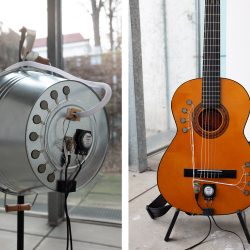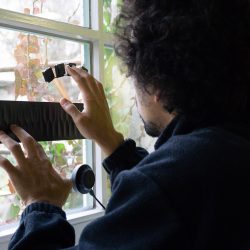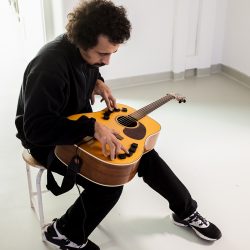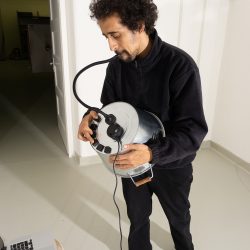Interaktion mit dem Ton
Description
A kit—consisting of a central hub with surface transducer and three different input devices—which makes it possible to turn resonating objects into new electronic musical instruments. This way either existing acoustic instruments can produce new sounds or random objects from every day life can become musical instruments.What is the Topic?
My initial goal was to create a new musical instrument that would combine the complexity and diversity of electronic sound creation with the clarity and haptic quality of acoustic instruments. Instead of just one instrument, what emerged is a kit enabling the creation of infinite new musical instruments. These new instruments can develop very individual personalities while still staying familiar in their interaction. The particular character of acoustic resonance bodies gets united with the endless creative possibilities of electronic sound design.
Why does it look like this?
The central hub includes the transducer, which makes the resonant body produce sound, and gets connected to computer or synthesizer via cable, the volume control at the perimeter always within reach. The wireless connection to the input devices prevents rattling cables while allowing for maximum freedom. While the single buttons can be chained in whatever number or shape desired, the piano controller enables slides between the notes, with haptic feedback about the fingers’ position. The breath controller may be played with or without tube which is prevented magnetically from hanging down. The black color fits well with different objects.
What is special?
Because of the separation between input and output device, playing a classic electronic musical instrument can often feel rather detached. The piano, too, has a longer distance between finger and vibrating string than, say, a violin. This separation is reduced in my object, as the input devices sit right on top of the resonant body, whose vibrations produce a very natural feeling while playing. By connecting to digital and analog synthesizers, their full freedom in sound design can be utilised. The resulting tone then gets influenced by the individual character of the chosen resonant body. This way an electronic sound can obtain an unexpectedly organic personality and a random object can develop an unexpected musicality. Playing a single note, electronic input devices like keyboards rarely detect much more than on and off. The input devices shown here, however, are designed for a much more fine and responsive interaction.
What is new?
New is, among other things, the unique marriage of electronic and acoustic sound creation. The wide variety of electronic sounds can be used, which then get refined by the individual character of the chosen resonant body. Suddenly it is possible to transform mute objects of daily life into musical instruments, which through the perceptible vibrations in the fingers even offer an exceptional closeness to the tone. The flexible arrangement of different input devices enables you to create an instrument tailored only to your tastes. The surface of the piano controller combines a familiar layout with the possibility of unprecedented virtuosity.






